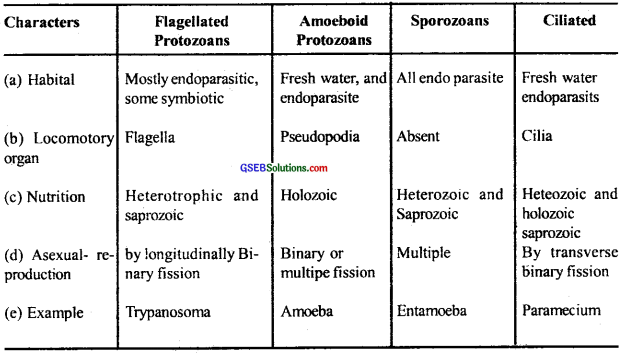Gujarat Board GSEB Textbook Solutions Class 11 Biology Chapter 2 Biological Classification Textbook Questions and Answers.
Gujarat Board Textbook Solutions Class 11 Biology Chapter 2 Biological Classification
GSEB Class 11 Biology Biological Classification Text Book Questions and Answers
Question 1.
Discuss how classification systems have undergone several changes over a period of time.
Answer:
Two kingdom systems were unable to describe photosynthetic, non-photosynthetic, uni, and multicellular organisms. Anatomical, environ-mental aspects become a great need for further description. Development in technology has provided many tools for scientists.
On the basis of cell-structure, mode of nutrition, reproduction, and phylogenetic relationship R.H. Whittaker has given five-kingdom classifications named Monera, Protista, Fungi, Plantae, and Animalia. But Whittaker has not described viruses, lichens like a cellular organism. These cause many infectious diseases. Stanley described vims, Viroids, smaller than viruses was discovered by T.O. Dienes. Thus classification systems have undergone several changes over a period of time and still changing.
![]()
Question 2.
State two economically important uses of:
(1) heterotrophic bacteria
(2) archaebacteria
Answer:
(1) Heterotrophic bacteria :
- Nitrogen fixation in roots of leguminous plants
- Being decomposers, used in the production of antibiotics
(2) Archaebacteria:
- Production of biogas from cow-dung.
- Lives in the guts of ruminant animals & help them in the digestion of starch.
![]()
Question 3.
What is the nature of cell-wall in diatoms?
Answer:
These are two thin overlapping shells, fitting, together. This wall is very tough because it is embedded with silica. Silica wall designed with five ridges lines, pores, etc. The outer wall is called epithica while the inner called hypothetical.
![]()
Question 4.
Find out what do the terms ‘algae bloom’ and ‘red-tides’ signify.
Answer:
Red-tides Some Dianoflagellates have red pigment in their cells. They multiply rapidly. These marine organisms make a red sheet overseas, Thus look red-tides. Algal bloom Colonies of cyanobacteria like Nostoc Anabaena form blooms in polluted water bodies are called an algal bloom.
![]()
Question 5.
How are viroids different from viruses?
Answer:
Virus:
- Smaller than bacteria
- Genetic material may be RNA or DNA
- Protein coat made up of capsomeres ate present.
- Causes diseases—Mumps, AIDS
Viroids:
- Smaller than viruses.
- The only RNA is present in free-form.
- Protein coat absent.
- Causes diseases—Potato, spindle tuber disease
![]()
Question 6.
Describe briefly the four major groups of Protozoa.
Answer:

![]()
Question 7.
Plants are autotrophic. Can you think of some plants that are partially heterotrophic?
Answer:
Plants contain chlorophyll. But some plants show the heterotrophic mode of nutrition.
(1) Insectivorous plants: Plants have specialized leaves to trap insects. The trapped insects are killed and digested by proteolytic enzymes secreted by the epidermis of the leaves. Ex. Pitcher plant
(2) Parasitic form: Cusentta develops haustoria, which penetrates into the vascular bundles of the host plant to absorb water and solutes.
![]()
Question 8.
What do the terms phycobilins and mycobiont signify?
Answer:
Lichens are the symbiotic association between algae and fungi. The fungal component is called mycobiont and the algae component is known as phycobilins.
![]()
Question 9.
Give a comparative account of the classes of Kingdom Fungi under the following:
- Mode of nutrition
- Mode of reproduction
Answer:

![]()
Question 10.
What are the characteristic features of Euglenoids?
Answer:
Euglenoids show the following distinguishing characters
- Freshwater, free-living found in ponds and ditches.
- Absence of cell-wall but contain flexible pellicle made up of protein
- All the euglenoids have one or two flagella which help in swimming.
- Bear a red-pigmented eyespot and a gullet near the base of the flagellum.
- Some are green and holophytic like other plants. Few are non-green and saprobic, some are like holographic animals.
- Store carbohydrates in the form of paramylum
![]()
Question 11.
Give a brief account of viruses with respect to their structure and the nature of genetic material. Also, name four common viral diseases.
Answer:
(1) The name vims mean venom or ‘Poisonbus fluid’. These are smaller than bacteria because they can be filterable by bacteria-proof filters. They are living organisms. They are not free-living in nature and occurs only as obligate intracellular parasites.
(2) Protein vims also contain genetic material RNA or DNA. Vim is a nucleoprotein and the genetic material is infectious. These are obligate parasites, self-replicating, non-cellular organisms.
(3) All plant viruses have single standard RNA and all animal viruses have either single or double standard RNA or double standard DNA.
(4) Bacterial viruses (Bacteriophage viruses that eat up the Bacteria) contain mostly double standard DNA. The protein coat protects the nucleic acid, called capsid made up of small subunits called capsomeres.
(5) These capsomeres are arranged in helical or polyhedral geometric forms. Viruses cause diseases like mumps, smallpox, Herpes, Influenza, and AIDS, etc. in humans.
(6) In plants the symptoms can be mosaic, leaf rolling and curling yellowing and vein clearing, dwarfing and stunted growth, etc.
Common viral diseases
- Cough and cold
- Mumps
- Smallpox
- Influenza
![]()
Question 12.
Organize a discussion in your class on the topic – ‘Are viruses living or non-living?’
Answer:
Viruses are linked between living and non-living. They possess some living characters and some non-living characters. Crystallization is a non-living character but it can reproduce inside a living body. Actually, they are metabolic ly inert when outside the host-cell. They reproduce using the metabolic machinery of the host cell and infect chemically.